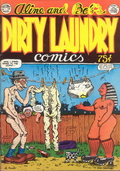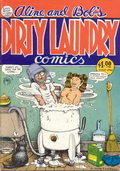Dirty Laundry

Dirty Laundry
Cartoonists Co-op Press / Last Gasp (1974-1978)
Aline Kominsky was 22 years old when she met the 28-year-old Robert Crumb in 1971 during a party at Terry Zwigoff and Kathy Goodell’s house in San Francisco. Kathy was actually Robert’s girlfriend at the time, but he was also still married to his first wife, Dana. But having a wife and a girlfriend didn’t stop Robert from flirting with Aline. “You have really cute knees,” was his opening line to Aline, and later that evening they were making out in Kathy’s upstairs bedroom. Their relationship couldn’t get serious until Robert straightened out the mess that was his personal life, but eventually he did (or at least began trying) and Robert and Aline launched their enduring romance.
By 1973, Robert’s home base (I say “base” because he still traveled quite a bit) was in an old cabin in Potter Valley, California, about 100 miles north of San Francisco, where his ex-wife Dana also lived in a house next door on the same lot. That same year, Aline moved up to Potter Valley to live next door to Robert’s cabin in an old trailer. Although Robert maintained relationships with other girlfriends and they didn’t live together, Robert and Aline were lovers and their relationship was destined to grow ever stronger.
In the fall of ’73, Aline broke her right foot when she slipped on Robert’s front porch, basically incapacitating her for most of the coming winter. While her foot healed for six weeks in a cast, Aline and Robert began working on a collaborative comic story just to pass the time, much like Robert did with his brother Charles when they were kids. Robert and Aline took turns writing the dialogue and drawing the panels, building an autobiographical but sometimes absurd comic that they never intended to publish. But when comic book publisher Keith Green (Justin Green’s brother) visited Robert’s place in 1974 and saw the comic, he said he wanted to publish it. Aline and Robert agreed, and they came up with the title Dirty Laundry Comics when they showed the comic to Terry Zwigoff, who exclaimed, “God this is so embarrassing, it’s like hanging out your dirty laundry for everyone to see!”
Dirty Laundry Comics #1 was published by Keith Green and Cartoonists Co-op Press in the summer of 1974. It features a single, rambling story that mixes insights on their relationship with a spaceship fantasy featuring LSD guru Timothy Leary (a huge fan of underground comics). The comic is unpolished in places, particularly the places where Aline got lazy with her drawing, but she didn’t expect her work to get published, so what did it matter? After the comic was published, Robert and Aline continued collaborating on comics and they began to take it more seriously, which might be why it took three years to complete the second issue.
Dirty Laundry Comics #2 was finally published by Last Gasp in January, 1978, by which time the Crumbs were soon to be married and well-settled in Winters, a small farm town in California’s Central Valley. The 30-page feature story covers three years in Robert and Aline’s life and is a masterpiece of autobiographical comics. It is funny, tragic and insightful, but above all searingly honest as it exposes the peculiar reality of Robert and Aline’s relationship.
To me, Dirty Laundry Comics #2 represents the beginning of their new life narrative and Robert’s evolving perspective, which would culminate with the simultaneous birthings of Weirdo magazine and Sophie Crumb in 1981. Robert and Aline were both innovators and veterans of the autobiographical comic story genre, but Dirty Laundry set a new standard in the way it shared scripting and artistic duties between two powerful voices.
Dirty Laundry only ran two issues as a comic book, but it became the launching point for three decades of collaborative, autobiographical comics produced by Robert and Aline. These comics appeared in Winds of Change (a local tabloid) in the ’70s, Weirdo in the ’80s, Self Loathing Comics in the ’90s (right after Dirty Laundry was anthologized in a trade paperback), and The New Yorker since the turn of the millenium. Ultimately, this extraordinary canon of remarkable comic collaborations will be deemed as one of Robert Crumb’s and Aline Kominsky’s greatest career achievements, which by default makes Dirty Laundry one of the greatest achievements in the history of comics.


